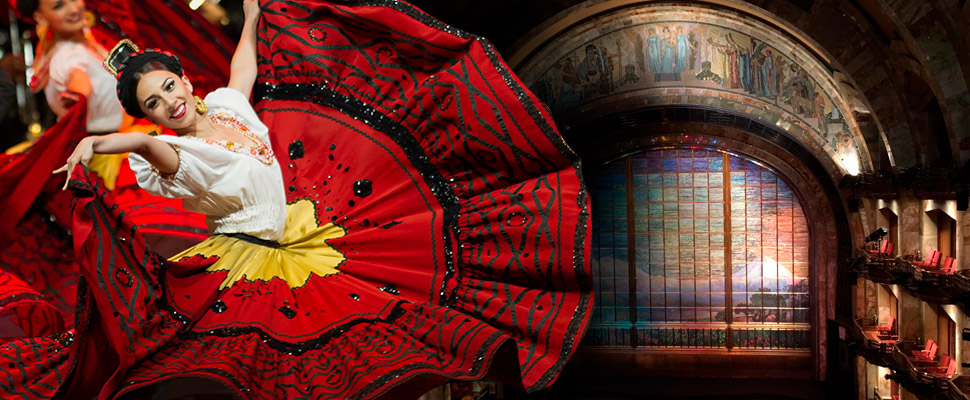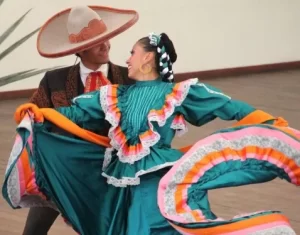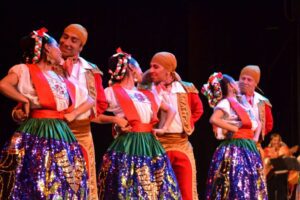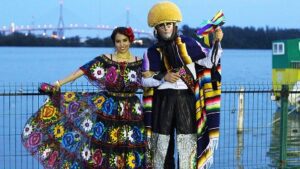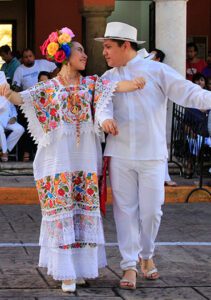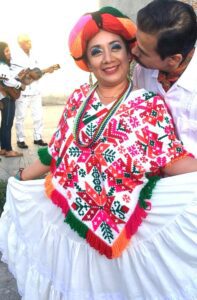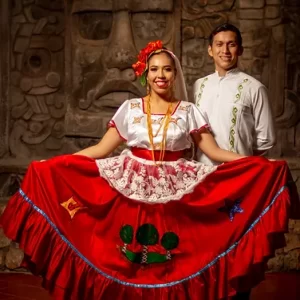As Mexicans, we are very proud of the cultural diversity that represents our country. Our delicious traditional dishes, our breathtaking landscapes, and our typical costumes, to mention only a few.
Each of the 32 states of Mexico is represented by its unique traditional costumes. An essential element in traditional popular festivities, handmade by Mexican artisans, garments that tell stories through their colors and designs.
Take a look at only some of the most beautiful typical costumes of Mexico and the World.
VERACRUZ
People who reside in this city are known as Jarochos, very proud citizens responsible for honoring their culture, mainly through their typical costumes. These are considered one of the most elegant costumes in all of Mexican culture.
During the Colonial era, Spanish women of Valencia and Andalucía, who settled in the towns near the Papaloapan river, used multi-layered dresses, made with heavy fabrics, which at the end of the day were unbearable to wear because of the climatic conditions of the city of Veracruz. With the passing of time they were replaced by garments made with much lighter fabric more according to the temperature, creating a fusion of indigenous and European elements.
The garments are done by hand by women from the region, which is essential due to all their details.
source: subohpgcollege.com
Jarocha (Her)
A representative element of the typical women’s costume of Veracruz is the use of white color, very representative of Nahuatl clothing.
This outfit consists of a white long-flying light-fabric skirt with two or three ruffles, with a black satin apron tied at the waist, showing embroidered flowers in red.
The shoulders are covered with a delicate raw cotton fabric in a triangle shape, and a silk shawl in the color red, black or white.
Finally, elements such as a comb with flowers, an embroidered hand-fan, and accessories such as gold necklaces and bracelets are implanted.
Jarocho (Him)
The Jarocho man’s costume consists of a white pleated guayabera-type shirt, plain white pants made of light fabric and white 6-cm high-heeled shoes.
In addition, a red bandana tied with a golden ring is used around the neck, and a white palm hat to top it off.
JALISCO
Jalisco’s typical costume is used both by the dancers of folkloric groups and by participants and attendees at charrería events, the national sport par excellence of Mexico.
This Is one of the most beloved, used, and marketed typical costumes throughout Mexico. Worldwide, it represents the joy, diversity, and passion for Mexican culture.
source: topadventure.com
Escaramuza (Her)
The typical clothing for Guadalajara ladies, combine beautiful colors achieving the perfect harmony between elegance and tradition. Made with a fabric called poplin in vibrant colors such as red or blue, combining its details with other shades. The upper part of this garment is very striking, the sleeves are slightly puffy, with a stylized high neck and several ruffles, decorating and adding dimension and movement to the costume. In order to walk freely and dance comfortably, low platform boots are suitable for this costume.
Charro (Him)
The typical Charro costume from Jalisco consists of a tight jacket and pants, decorated with up to seventy silver or gold buttons, however, the star of this outfit is the classic Sombrero de Charro. Boots and the whole suit should be the same color, which tends to be black, white, gray, or blue.
There is a second typical female costume that is quite similar to men’s Charro costume and is commonly used by Female Mariachis.
PUEBLA
A city located in Mexico’s central area, well known for its history, traditional costumes, and delicious food. The legend goes that in the 18th century, the appearance of a mysterious woman who was said to be a slave from Indonesia, and which natives began to call “China” was the inspiration for Puebla’s traditional costume, due to the exotic clothes she wore on her walks through town. In no time, the area’s residents began to imitate this particular way of dressing and manufacture clothes of that style. Over the years, this oriental fashion merged with the fashion trends of those times, thus giving birth to the regional Mexican skirt from Puebla. A cultural mix between prehispanic, Spanish, and oriental, elegant and striking at the same time.
source: iov.world
China Poblana (Her)
The traditional costume of the China Poblana is characterized by having many details, it consists of a long skirt where the colors green, white and red predominate. Sequins, ruffles, and tulle are also added.
On the other hand, the waist is highlighted with a strip to divide the skirt of the blouse, which is white and embroidered with very cheerful colors. Finally, the accessories that finish the outfit are very striking long necklaces.
(Him)
The traditional costume from Puebla for men has characteristics similar to those of the Charros of Guadalajara. It consists of a decorated shirt whose patterns and colors may vary but is always combined with the China Poblana costume. The set is complemented by a belt at the waist and flared pants, either black or in harmony with the upper pieces. To finish, they wear a bandana or scarf tied around their heads.
CHIAPAS
The wonderful state of Chiapas is highly visited by travelers from all over the world. Due to its proximity to the Yucatan Peninsula, the Mayan influence can be clearly seen in its lifestyle, traditions, gastronomy, and the cultural wealth of native peoples. Currently, each community has its own way of understanding life and preserving its ancestral knowledge. Through their colorful and popular clothing, many of these people communicate their history, their experiences, and their beliefs.
source: ecured.cu
Chiapanecas (Her)
The Chiapanecas costume is one of the most beautiful traditional costumes of Mexico, consisting of a black satin blouse, adorned with a wide tulle flight full of hand-embroidered flowers in silk thread of multiple bright colors such as yellow, pink, and blue.
The skirt, also made of black satin, is long to the floor with various pleats and ruffles, each one with various colorful hand-embroidered flowers.
The fact of adding various flowers to the dresses is to somehow refer to the large number of botanical species that are known in Chiapas.
Each community has its own unique patterns, that way women are able to represent their community with their garments.
Parachico (Him)
The attire for men is the traditional Parachico, made up of a white or black shirt, black pants, black shoes, and the renowned colorful sarape, a red sash, and scarves embroidered with flowers or religious motifs hanging from the waist to cover the feet.
The traditional Parachico mask represents the features of the Spaniards who colonized the Chiapas people, in the same way, the montera represents their blond hair. All this is in order to make fun of the conquerors.
YUCATAN
The traditional costumes of Yucatán emerged during the conquest, a mixture of indigenous and Spanish techniques, using local textiles that the indigenous people used for their great quality. The garments are woven by the hand of artisans and what usually stands out is the diversity of colored flowers that are made with the cross-stitch technique.
This is considered one of the most elegant outfits in the entire Mexican culture, with a touch of color that represents the beauty and dynamism of the women of the republic.
source: merida.gob.mx
Terno (Hers)
Traditional costume that consists of 3 different pieces, which takes about 6 months to be ready.
Jubón: Square lapel that goes above the shoulders and reaches below the chest.
Huipil: It has a dress-like cut and is the longest garment of the entire suit. It is handmade with fine silk cotton and embroidered with different colored flowers.
Fustán: simulates a half bottom, fits from the waist below the huipil, and reaches the ankles or feet, highlighting the embroideries that match the Jubón. Made of lace or embroidered with cross stitch.
Finally, the neck is adorned with long and luxurious gold filigree rosaries and thick coral beads, carved by craftsmen from the country.
Mestizo (His)
The mestizo costume consists of a white guayabera typical of Yucatan with white pants made of light fabric and a red bandana standing out in one of the pockets.
Also, the important elements of this traditional costume are the Jipi straw hat that is woven by hand and the chillonas, a type of cowhide leather sandal, as well as high and thick heels that emit a small screech when dancing.
SAN LUIS POTOSI
The state of San Luis Potosí is characterized by its natural wonders, especially the Huasteca Potosina, a large part of its wonders represent the indigenous culture and among them is their traditional costume.
source: i.pinimg.com
Huastecas (Her)
Huastecas costume is made with raw cotton, completely flat in the back and wide folds in the front. In the same way, the waist stands out with a sash with red and blue stripes.
In addition, the blouse is white with puffed sleeves. Lastly, the most important element is the quexquémitl [keʃ’ke.mitl] that goes over the suit and is adorned with cross-stitch embroidery, representing this region’s flora and fauna.
They also decorate their heads with a headband of pre-Hispanic influence and made with skeins of yarn of different shades.
Huastecos (Him)
The costume of the Huasteca Potosína man is much simpler, its use is limited to older people in some regions of San Luis Potosí. It consists only of raw cotton shirts and pants. The accessories are primarily red bandannas or scarves. Potosi men usually wear this ensemble barefoot or wear huaraches with a straw or palm hat to cover their heads.
Among the residents and connoisseurs of San Luis’s traditional costumes, it is well known that the women’s costume stands out above the male because its complexity and level of visual detail are designed so that they are the protagonists.
QUINTANA ROO
The main attraction of Quintana Roo is its beautiful beaches. Thousands of tourists travel just to visit them and to try the incredible gastronomic variety that the Mexican Caribbean represents. It should be noted that it is not merely a dress that has been used traditionally but rather seeks to represent the wonders of the state. The Mayan costume is inspired by the outfits worn by Mayan princesses in ancient times.
In the woman’s skirt, snails, three pine trees, and stars stand out, which can be embroidered or painted. The snails mean marine wealth and represent the first communication tool between the Mayans. The pines represent our forest’s wealth, energy, and creativity from Quintana Roo and the stars represent the morning star or the passage of Venus that the ancient Mayans observed as astronomers. In the same way, the accessories that stand out in the costumes are pre-Hispanic representatives.
source: bafqroo.com
The beauty in the manufacturing details of each traditional costume reflects the impeccable work of Mexican artisans. Parts of our history are represented in each thread and in each embroidery which is carried by proud citizens of their strong Mexican roots.
The Eating With Carmen Food Tours Team encourages you to travel across our beloved Mexico to experience our culture as much as you can. Remember to shop at local stores for traditional pieces of Mexican fashion and take a little piece of Mexico with you to wear everywhere.
See you around!
-Abbey.

